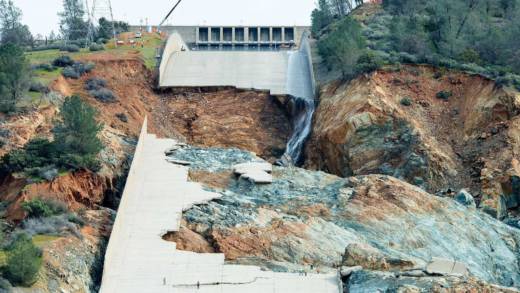For high hazard and extremely high hazard dams -- the ratings reflect the potential hazard to downstream communities, not the condition of the facilities themselves -- the new law requires reviews of the facilities' original design and construction as well as consideration of a host of other factors, including structures' current "geotechnical, structural, hydraulic, hydrological, geologic, seismic hazard, monitoring and instrumentation."
That provision grows out of the January report from an independent forensic team appointed by DWR at the direction of federal regulators.
The team said it had "not seen any indication that such a review was ever conducted for the service (main) spillway chute at Oroville Dam since the original construction. ... Such a review would likely have 'connected the dots' " of factors that led to the spillway failure.
Gallagher told The California Report on Tuesday that bringing in outside perspectives and regularly re-evaluating inspection standards are steps intended to address investigators' criticism of DWR as "an insular organization."
"We want to get to where we're operating at the highest level of public safety at these dams," Gallagher said. "And I think this outside perspective of constantly challenging our thinking, and requiring that our thinking be challenged when we update our protocols, that's what's going to help us get there."
Other major provisions of AB 1270:
- Dams with hazard ratings of significant, high or extremely high -- categories comprising more than two-thirds of California dams -- shall be inspected at least once per fiscal year.
- Inspections will include visual inspections of major dam features and the dam’s outlet works (i.e., spillways).
- Dam owners must operate critical outlet and spillway control features on an annual basis and shall demonstrate their full operability in the presence of the department every three years or as directed by the department.
Robert Bea, a professor emeritus of civil engineering at UC Berkeley who has led an outside effort to analyze the spillway failures, said he was encouraged by the bill but feels it's only the first of many steps that the Department of Water Resources and regulatory agencies will need to take to improve safety at Oroville and dams around the state.
"I'm very heartened by what Assemblyman Gallagher and his colleagues have done," Bea said Monday. "We've recognized that we've got an important challenge regarding our dam infrastructure and water infrastructure systems here in California."
He praised the new law's embrace of risk-based management of the state's dams -- an approach that looks beyond the results of individual inspections and considers the consequences of major failures of dam and infrastructure systems.
"This is known internationally as goal-based management," Bea said. "And the goal is to consistently develop and maintain risks that are as low as reasonably practicable."
But Bea, who has been critical of the Department of Water Resources and its actions before and since the Oroville events, added that he believes major, permanent change is needed in the agency's culture, competence and leadership to accomplish the law's safety goals.
"Yes, the bill is a great first step -- to a trail that never ends," he said.
